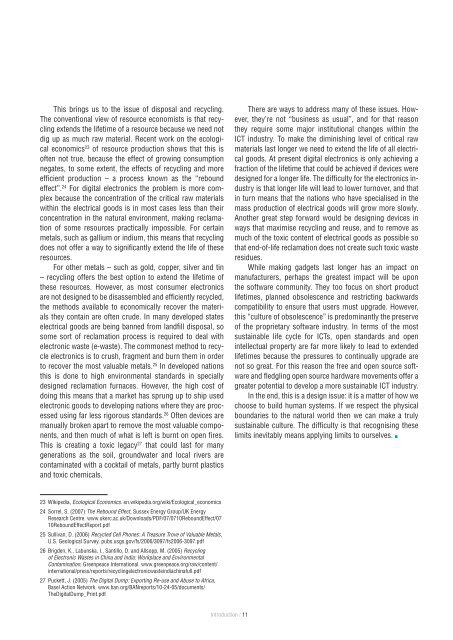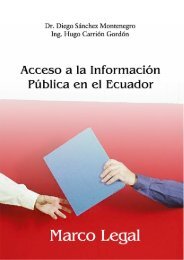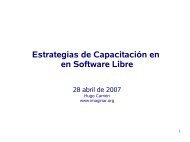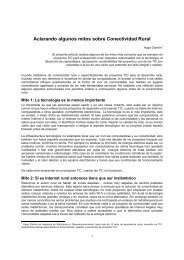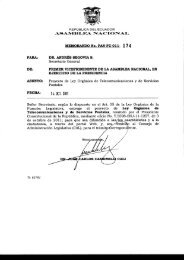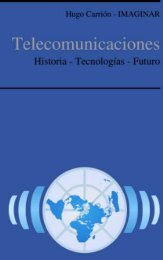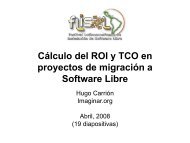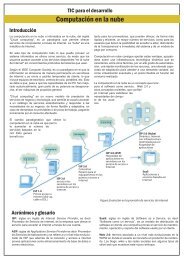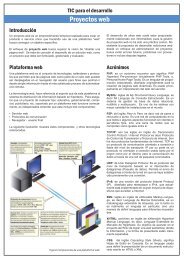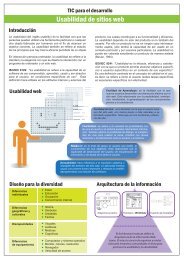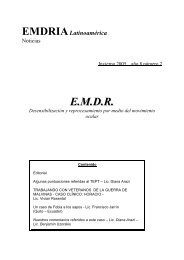GLOBAL INFORMATION SOCIETY WATCH 2010
GLOBAL INFORMATION SOCIETY WATCH 2010
GLOBAL INFORMATION SOCIETY WATCH 2010
You also want an ePaper? Increase the reach of your titles
YUMPU automatically turns print PDFs into web optimized ePapers that Google loves.
This brings us to the issue of disposal and recycling.<br />
The conventional view of resource economists is that recycling<br />
extends the lifetime of a resource because we need not<br />
dig up as much raw material. Recent work on the ecological<br />
economics 23 of resource production shows that this is<br />
often not true, because the effect of growing consumption<br />
negates, to some extent, the effects of recycling and more<br />
efficient production – a process known as the “rebound<br />
effect”. 24 For digital electronics the problem is more complex<br />
because the concentration of the critical raw materials<br />
within the electrical goods is in most cases less than their<br />
concentration in the natural environment, making reclamation<br />
of some resources practically impossible. For certain<br />
metals, such as gallium or indium, this means that recycling<br />
does not offer a way to significantly extend the life of these<br />
resources.<br />
For other metals – such as gold, copper, silver and tin<br />
– recycling offers the best option to extend the lifetime of<br />
these resources. However, as most consumer electronics<br />
are not designed to be disassembled and efficiently recycled,<br />
the methods available to economically recover the materials<br />
they contain are often crude. In many developed states<br />
electrical goods are being banned from landfill disposal, so<br />
some sort of reclamation process is required to deal with<br />
electronic waste (e‐waste). The commonest method to recycle<br />
electronics is to crush, fragment and burn them in order<br />
to recover the most valuable metals. 25 In developed nations<br />
this is done to high environmental standards in specially<br />
designed reclamation furnaces. However, the high cost of<br />
doing this means that a market has sprung up to ship used<br />
electronic goods to developing nations where they are processed<br />
using far less rigorous standards. 26 Often devices are<br />
manually broken apart to remove the most valuable components,<br />
and then much of what is left is burnt on open fires.<br />
This is creating a toxic legacy 27 that could last for many<br />
generations as the soil, groundwater and local rivers are<br />
contaminated with a cocktail of metals, partly burnt plastics<br />
and toxic chemicals.<br />
There are ways to address many of these issues. However,<br />
they’re not “business as usual”, and for that reason<br />
they require some major institutional changes within the<br />
ICT industry. To make the diminishing level of critical raw<br />
materials last longer we need to extend the life of all electrical<br />
goods. At present digital electronics is only achieving a<br />
fraction of the lifetime that could be achieved if devices were<br />
designed for a longer life. The difficulty for the electronics industry<br />
is that longer life will lead to lower turnover, and that<br />
in turn means that the nations who have specialised in the<br />
mass production of electrical goods will grow more slowly.<br />
Another great step forward would be designing devices in<br />
ways that maximise recycling and reuse, and to remove as<br />
much of the toxic content of electrical goods as possible so<br />
that end-of-life reclamation does not create such toxic waste<br />
residues.<br />
While making gadgets last longer has an impact on<br />
manufacturers, perhaps the greatest impact will be upon<br />
the software community. They too focus on short product<br />
lifetimes, planned obsolescence and restricting backwards<br />
compatibility to ensure that users must upgrade. However,<br />
this “culture of obsolescence” is predominantly the preserve<br />
of the proprietary software industry. In terms of the most<br />
sustainable life cycle for ICTs, open standards and open<br />
intellectual property are far more likely to lead to extended<br />
lifetimes because the pressures to continually upgrade are<br />
not so great. For this reason the free and open source software<br />
and fledgling open source hardware movements offer a<br />
greater potential to develop a more sustainable ICT industry.<br />
In the end, this is a design issue: it is a matter of how we<br />
choose to build human systems. If we respect the physical<br />
boundaries to the natural world then we can make a truly<br />
sustainable culture. The difficulty is that recognising these<br />
limits inevitably means applying limits to ourselves. n<br />
23 Wikipedia, Ecological Economics. en.wikipedia.org/wiki/Ecological_economics<br />
24 Sorrel, S. (2007) The Rebound Effect, Sussex Energy Group/UK Energy<br />
Research Centre. www.ukerc.ac.uk/Downloads/PDF/07/0710ReboundEffect/07<br />
10ReboundEffectReport.pdf<br />
25 Sullivan, D. (2006) Recycled Cell Phones: A Treasure Trove of Valuable Metals,<br />
U.S. Geological Survey. pubs.usgs.gov/fs/2006/3097/fs2006-3097.pdf<br />
26 Brigden, K., Labunska, I., Santillo, D. and Allsopp, M. (2005) Recycling<br />
of Electronic Wastes in China and India: Workplace and Environmental<br />
Contamination, Greenpeace International. www.greenpeace.org/raw/content/<br />
international/press/reports/recyclingelectronicwasteindiachinafull.pdf<br />
27 Puckett, J. (2005) The Digital Dump: Exporting Re-use and Abuse to Africa,<br />
Basel Action Network. www.ban.org/BANreports/10-24-05/documents/<br />
TheDigitalDump_Print.pdf<br />
Introduction / 11


